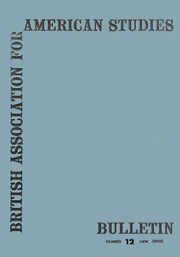No CrossRef data available.
Article contents
Three Unpublished Letters of George Ticknor and Edward Everett
Published online by Cambridge University Press: 17 February 2011
Extract
William Roscoe of Liverpool, banker, historian and man of letters, was George Ticknor and Edward Everett's “first celebrity” in their 1815–1819 European apprenticeship. Roscoe stood for them, as he does in Washington Irving's The Sketch-Book of Geoffrey Crayon, Gent. (1819–20), as “the literary landmark” of Liverpool, and more than that, a gateway to European culture. His house was open to Americans and he introduced them to and sped them on their repossessions of the heritage on which, in the previous years, the young country had turned its back.
- Type
- Research Article
- Information
- Copyright
- Copyright © British Association for American Studies 1964




